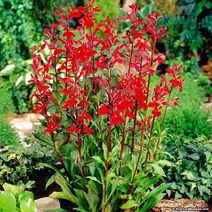Lobelia cardinalis
| Lobelia cardinalis | |
 | |
| Light: | |
| Moisture: | |
| Hardiness: | 3 |
| Soil pH: | 5.6-8.4 |
| Height: | 3' |
| Width: | 1' |
| Blooms: | Mid Summer-Late Summer |
| Native to: | |
| Nectary | |
| Medicinal Rating: | |
| Tea: | Yes |
Lobelia cardinalis (common name: cardinal flower)
A magnet for swallowtail butterflies and ruby-throated hummingbirds, this perennial is named after the vesture color of Roman Catholic cardinals and not the bird who, along with other birds, are uninterested in this flower due to its small seeds. Intense blossoms form on 8” spikes with each flower form a tube from two rising upper petals and three spreading lower petals. While it was relatively common, over-picking of this wildflower has caused scarcity in some regions. The low-maintenance plant needs full sun to part shade and constant moisture from stream banks, water edges, or rain gardens. The flower takes two years to bloom, forming a large rosette the first year, and readily self seeds in optimum conditions. The genus was named in honor of Flemish botanist Matthias de l’Obel.
Propagation: Seed - best sown as soon as it is ripe in a cold frame[1]. When they are large enough to handle, prick the seedlings out into individual pots and grow them on in the greenhouse for their first winter. Plant them out into their permanent positions in late spring or early summer, after the last expected frosts.
Division in spring[1].
Basal cuttings in spring[2]. Harvest the shoots when they are about 10cm long with plenty of underground stem. Pot them up into individual pots and keep them in light shade in a cold frame or greenhouse until they are rooting well. Plant them out in the summer.
Layering in moist sand, it forms roots at the nodes[1].
Cultivation: Requires a deep rich soil and plenty of moisture[2][1]. Grows well in heavy clay soils. Succeeds in standing water though is not then so long lived[1]. Succeeds in full sun or light shade[1]. Requires protection from the wind[1].
Dormant plants are hardy to at least -25°c[3], though they can be excited into premature growth in mild winter areas and are then more susceptible to frost damage[1].
A very ornamental plant[2].
Hybridizes freely with other members of this genus.
Range: N. America - New Brunswick to Quebec, south to Florida and Texas.
Habitat: Damp shores, meadows and swamps[4].
Medicinal: Emetic, expectorant and nervine[5][6].
The root is analgesic, anthelmintic, antispasmodic and stomachic[5][6][7]. A tea made from the roots has been used in the treatment of epilepsy, syphilis, typhoid, stomach aches, cramps, worms etc[8][7]. A poultice of the roots has been applied to sores that are hard to heal[7].
The leaves are analgesic and febrifuge[7]. A tea made from the leaves is used in the treatment of croup, nosebleeds, colds, fevers, headaches etc[8]. A poultice of the leaves has been applied to the head to relieve the pain of headaches[7].
This species is considered to have similar medicinal activity to L. inflata, but in a milder form[8]. It was seldom if ever used[8].
The plant is used to make a homeopathic remedy[5]. The report does not say which part of the plant is used, nor what it treats.
Soil: Can grow in light, medium, and heavy soils.
Flower Type: Hermaphrodite
Heavy Clay: Grows in heavy-clay soils.
Known Hazards: The plant is potentially toxic, but the degree of toxicity is unknown[8]. It contains the alkaloid lobeline which has a similar effect upon the nervous system as nicotine[9].
he sap of the plant has been known to cause skin irritation[9].
Links
References
- ↑ 1.0 1.1 1.2 1.3 1.4 1.5 1.6 1.7 Huxley, Anthony. The New Royal Horticultural Society Dictionary of Gardening. MacMillan Press, 1992.
- ↑ 2.0 2.1 2.2 Chittendon, Fred. RHS Dictionary of Plants. Oxford University Press, 1951.
- ↑ Phillips, Roger and Martyn Rix. Perennials - The Definitve Reference. Pan Books, 1991.
- ↑ Lyndon, Merritt. Gray's Manual of Botany. American Book Co, 1950.
- ↑ 5.0 5.1 5.2 Grieve, Margaret. A Modern Herbal. Penguin, 1984.
- ↑ 6.0 6.1 Usher, George. A Dictionary of Plants Used by Man. Constable, 1974.
- ↑ 7.0 7.1 7.2 7.3 7.4 Moerman, Daniel. Native American Ethnobotany. Timber Press, 1998.
- ↑ 8.0 8.1 8.2 8.3 8.4 Foster, Steven and Billy Tatum. Medicinal Plants of Eastern and Central North America. Houghton Mifflin, 1990.
- ↑ 9.0 9.1 Diggs, George and Barney Lipscomb. Illustrated Flora of North Central Texas. Botanical Research Institute, 1999.